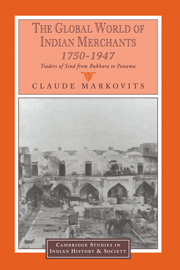Book contents
- Frontmatter
- Contents
- List of maps
- List of tables
- Acknowledgements
- Glossary
- Introduction
- 1 South Asian merchant networks
- 2 The regional context: Sind economy and society, c. 1750–1950
- 3 The Gate of Khorrassan: the Shikarpuri network, c. 1750–1947
- 4 From Kobe to Panama: the Sindworkies of Hyderabad
- 5 Patterns of circulation and business organization in two merchant networks
- 6 The business of the Sind merchants
- 7 The politics of merchant networks
- 8 Community and gender in two merchant networks
- 9 Epilogue: the Sindhi diaspora after 1947
- Conclusion
- Appendices
- Bibliography
- Index
5 - Patterns of circulation and business organization in two merchant networks
Published online by Cambridge University Press: 22 October 2009
- Frontmatter
- Contents
- List of maps
- List of tables
- Acknowledgements
- Glossary
- Introduction
- 1 South Asian merchant networks
- 2 The regional context: Sind economy and society, c. 1750–1950
- 3 The Gate of Khorrassan: the Shikarpuri network, c. 1750–1947
- 4 From Kobe to Panama: the Sindworkies of Hyderabad
- 5 Patterns of circulation and business organization in two merchant networks
- 6 The business of the Sind merchants
- 7 The politics of merchant networks
- 8 Community and gender in two merchant networks
- 9 Epilogue: the Sindhi diaspora after 1947
- Conclusion
- Appendices
- Bibliography
- Index
Summary
The Shikarpuri and Hyderabadi networks displayed largely similar spatial configurations, in which the network centres were separated from the actual places of business by vast distances. This spatial configuration in its turn largely shaped the way business was organized. Although such a physical separation between the network centres and the actual places of business was not unique to those two networks, the solutions elaborated by the merchants of Sind to deal with the problem were fairly specific. The major device used by the Shikarpuri merchants, who were the first in the field, was a system of partnership known as the shah-gumastha; the Hyderabadi merchants adopted it at first, but gradually modified it. Distance, with the attendant problems of communication it posed, dictated a pattern of functional specialization, by which only a limited number of financial operations, such as accounting, took place in the network centres, while all the commercial operations and some types of financial operations were performed in the actual place of business. This dissociation implied a pattern of regular circulation between the two poles. This was a multiform and multilayered circulation, in which financial and manpower flows did not move along the same lines. While capital flowed unidirectionally from the centres to the actual places of business (to return only in the form of remitted profits), manpower constantly moved to and fro between the two poles.
- Type
- Chapter
- Information
- The Global World of Indian Merchants, 1750–1947Traders of Sind from Bukhara to Panama, pp. 156 - 184Publisher: Cambridge University PressPrint publication year: 2000



